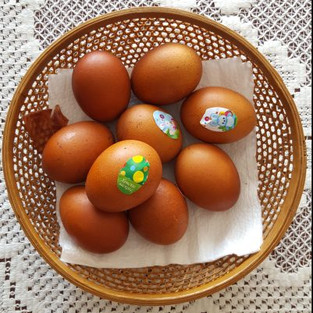
Good morning world! I have been home for the passed 2 weeks, and there is honestly no better feeling than spending time with family – especially with mine, since we live in literally 3 different continents. While the Catholic world celebrated Easter last week, we Orthodox celebrated it yesterday, so I thought it would be fun to share our customs and traditions.
Easter is the most joyous holiday for Orthodox Christians as it celebrates Jesus’ resurrection, which inspires hope, and for most years it has been held during Spring, which inspires change and awakening. It is also a time when the family gather and forgive each other from all previous arguments. 40 days before Easter, we are supposed to fast by abstaining from consuming animal products, which would purify our minds and bodies, and prepare us for communion on Easter Sunday. Good Friday, the day which Christ was betrayed and sentenced, is the saddest in the Christian world, and throughout Serbia, liturgies are held all day to mark the important historical events. It is also the day on which we decorate our eggs, in preparation for Sunday.
Colouring eggs is a very important element in our traditions, but you may be wondering where it came from. Throughout the Christian world, eggs symbolize eternal life, and the tradition comes from Mary Magdalene, who took painted red (symbolizing Christ’s blood) eggs to Roman Emperor Tiberius, when Christ resurrected. In an Orthodox household, the first egg is always a red one, and is the most important one. It is named as the protector of the household, and kept in the fridge for an entire year until the following Easter. I remember my mom always rubbing the red egg onto our cheeks as kids (and until today), in order to protect us from any harm.
In my family, up to 500 eggs are coloured during Easter, as we have the tradition of exchanging these beautiful eggs to all visitors on Easter Sunday, no one is left empty handed! These eggs are never fully consumed on Easter, so breakfast, lunch and dinner are sorted for the entire week! 🙂 The practice of colouring eggs nowadays is done commercially with cheap dye which is purchased at any grocery store, however traditionally Serbs coloured them with onion skins and flowers – a tradition which my granny still practices. We also have the tradition of “Egg Wars” where each person selects their champion egg and smashes it against a competitor – the one which does not crack, is the winner!
A liturgy (mass) is held on Saturday evening at midnight leading into Easter Sunday – which starts with a special greeting “Hristos Vaskrese, Vaistinu Vaskrese” translating to “Christ has risen, indeed He has risen”. The tradition follows with the exchange of eggs, leading to fun egg wars. Easter lunch is an affair on its own and usually consists of 5 + courses. Delicacies in my family include: chicken soup, salad, “sarma” (fermented cabbage leaves stuffed with minced meat), “rinflaish” (a dish we inherited from the Germans “rindfleisch” – meat and veggies which are boiled in a soup and eaten with horseradish or mustard), more roasted meat, either pork or lamb, coloured eggs, and of course plenty of cakes!
Let me go back to “sarma” for a second, which is a mandatory dish in every Serbian household, and my ULTIMATE favourite in our cuisine. Minced meat, rice and onions are sauteed, stuffed into fermented cabbage leaves, and cooked to perfection – I can literally eat this every single day!
The afternoon after lunch is generally a blur – I mean how do you recover after such a food coma?! 🙂 How is Easter celebrated in your country? What traditions do you follow?
xo,
Marina
Disclaimer: All views are my own and all photographs are © My Sweet Escapes.


















Comments